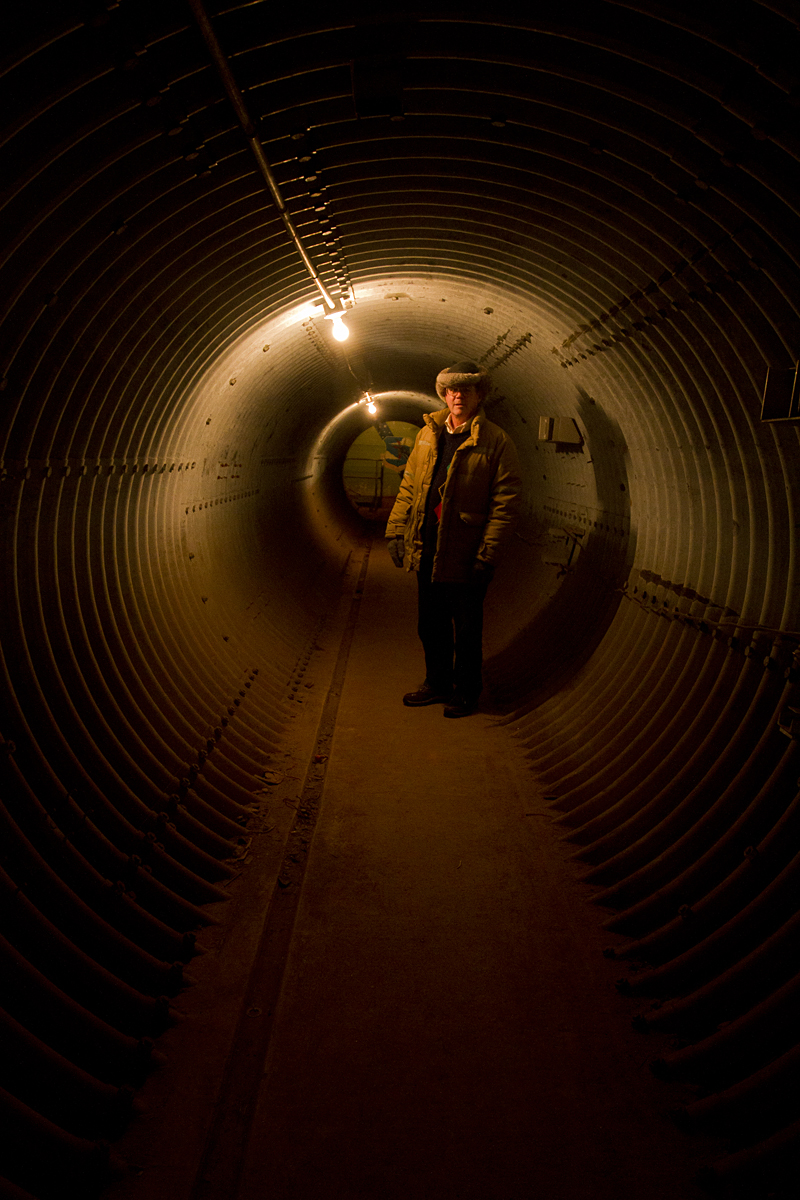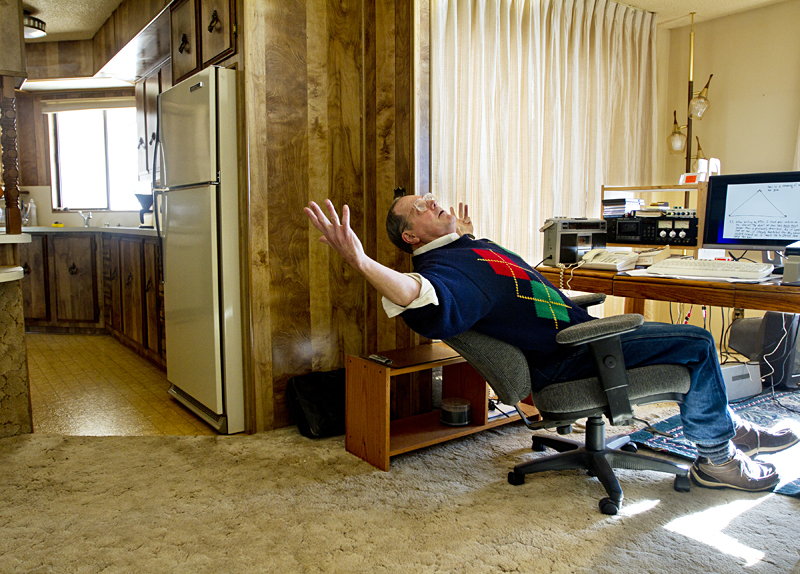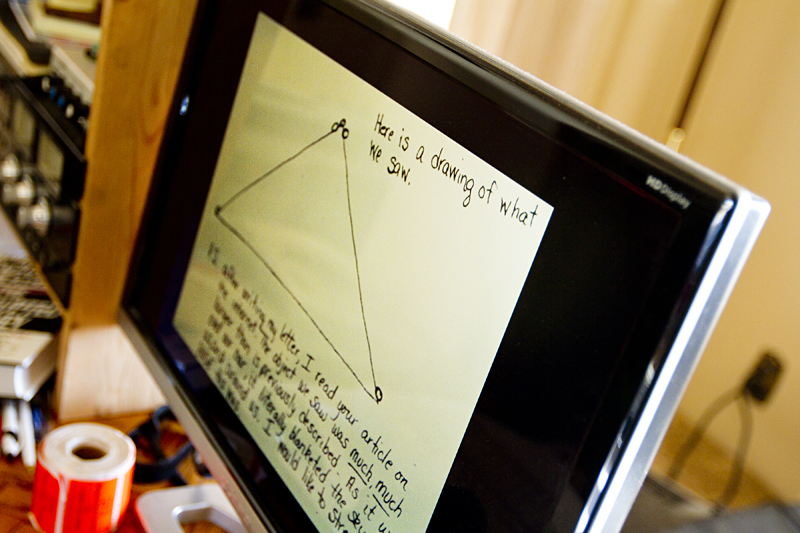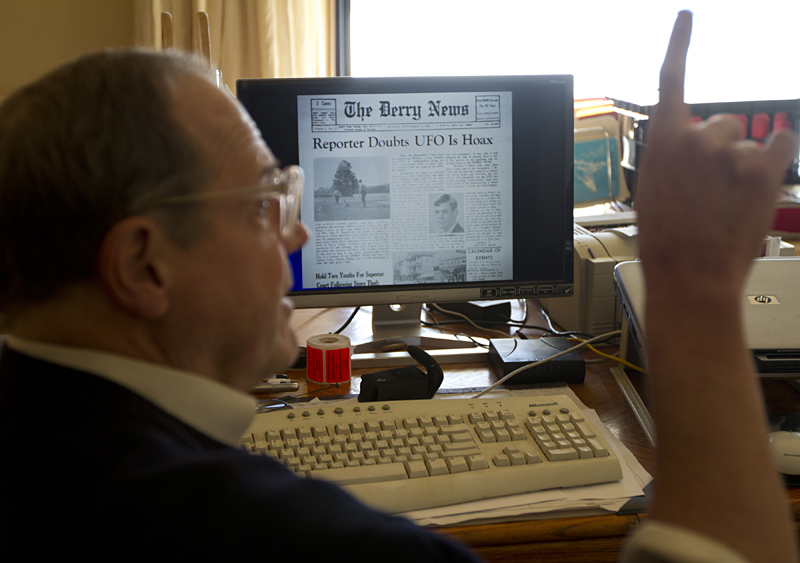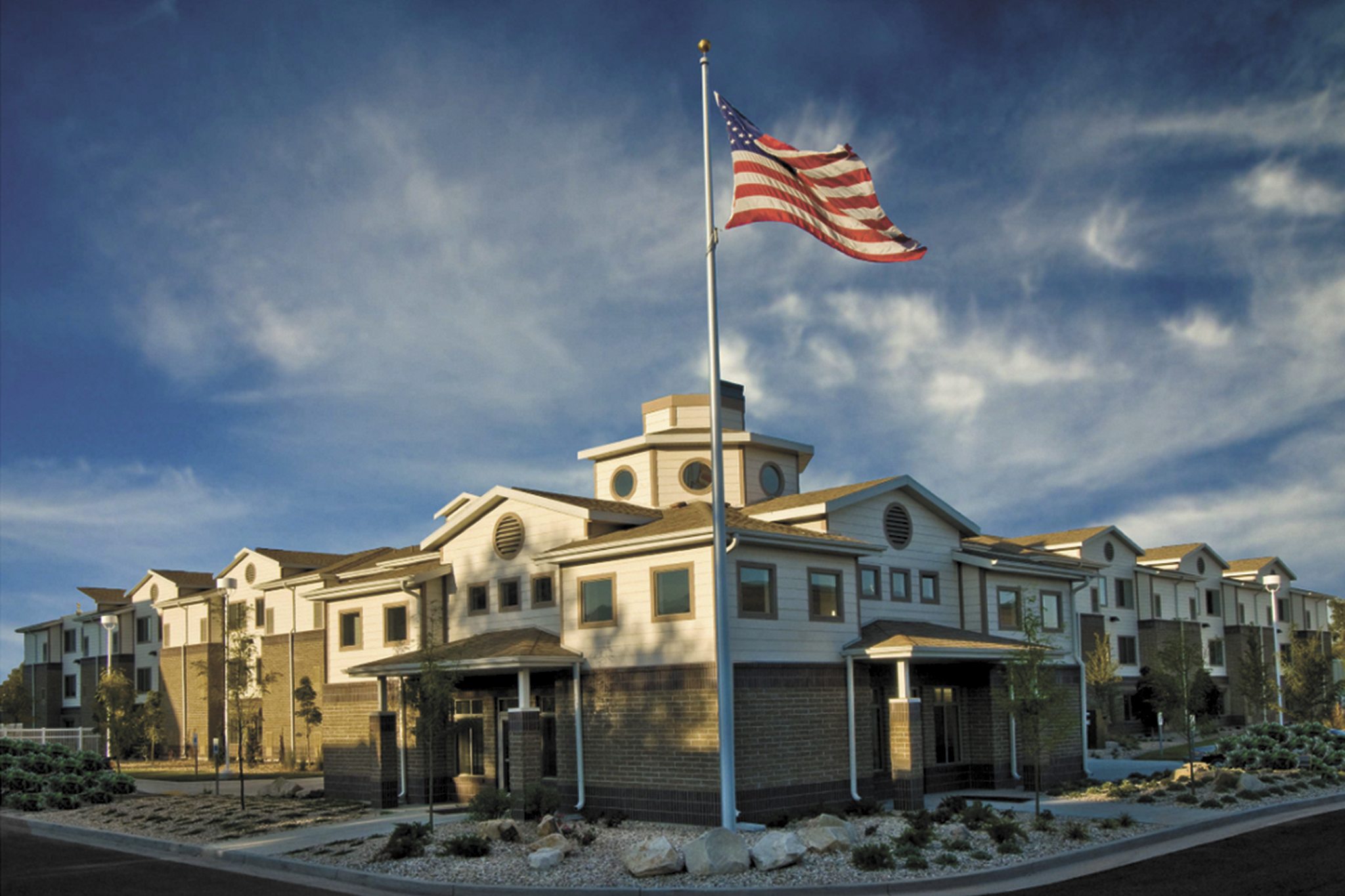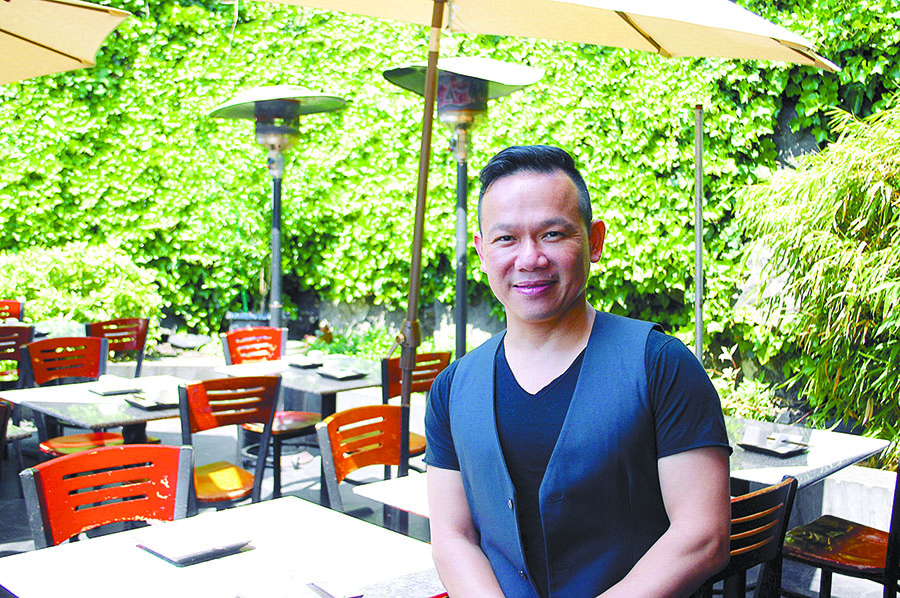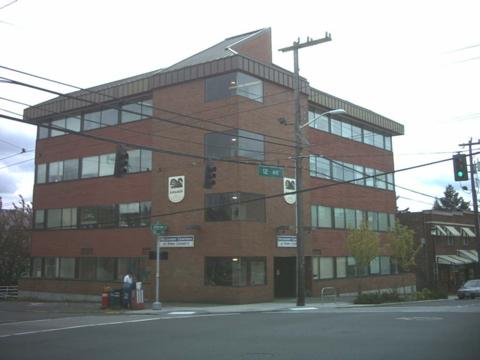On a bitterly cold mid-January afternoon on the outskirts of Harrington, Wash., a wheat-farming hamlet 50 miles west of Spokane, grain silos sprout on the edges of a snow-bleached horizon. Scrub brush and frozen tumbleweed skitter across a windswept terrain that in the early 1900s Lincoln County residents called a “howling desert.” It is home to bobcats, coyotes, and a massive underground nuclear bunker, where once, in its enormous cement-encased womb, a 3.75-megaton intercontinental ballistic missile was pointed straight at the Soviet Union.
The unholy shrine to the Cold War now belongs to Peter Davenport, a nationally prominent investigator of unidentified flying objects. Over the past decade and a half, Davenport has almost single-handedly put Washington state on the map as a hotbed of UFO research.
Years ago, Ralph H. Benson lived alone in this dark, dank subterranean fortress, an abandoned missile site he purchased in 1983, more than two decades after the government decommissioned the complex and returned its 22 barren acres to the public. An independent trucker, Benson had fallen far behind in his taxes, so agreed to meet at his missile cave with Roger Erdman, a state fuel-tax auditor. On June 12, 2002, Benson proceeded to shoot the tax man in the head and, with a set of flesh knives, dismember his body with such uncanny precision that Washington State Patrol investigators suspected he might have killed before.
“We think there is a high probability there are other victims out there,” State Patrol Detective Ken Wade told the Associated Press in 2004, referring specifically to the disappearance of an Illinois trucker, John Warren Deetz, last seen at a Spokane Valley truck stop on December 30, 1988.
Benson thwarted all hopes of additional confessions when he died of natural causes at age 65 in September 2004. Two years later, Davenport, one of the most recognized ufologists in the U.S., bought the missile site from the killer’s sons and moved his extraterrestrial-tracking operation from Seattle to Harrington.
Beneath icy-blue skies this January day, Davenport moves gingerly down a slippery slope that leads to the missile bunker. “Careful, now,” he cautions, “there may be wolves out here. Let’s stay together.” Davenport is the longtime director of the National UFO Reporting Center, an independently operated 24-hour hotline for UFO sightings, which he’s run in Washington since 1994. Each year he posts on his website (ufocenter.com) as many as 5,000 sightings, taping callers and making written reports. He figures he has 70,000 sightings on file; he’d surely turn them over to the government, he says, if only they’d ask.
Navigating the entryway where the nuclear bomb was gently backed into the cathedral-sized launch room, Davenport posits, “I estimate that 90 to 98 percent of all UFO sightings are explainable events—a satellite, an aircraft, a weather balloon, or a light on a distant airplane. You wouldn’t believe the number of calls I get when the International Space Station goes over.”
The UFO Reporting Center is known worldwide among UFO enthusiasts, as it is among law-enforcement agencies and 911 emergency dispatch centers. A one-man operation, Davenport, 63, who never married nor had children, works almost every day, “from wake-up to lights-out,” and fully funds the hotline out of his own pocket—costs which can range from $500 to $5,000 a month, depending on how much he travels.
The small fortune he made selling his stock in BioSyn, a Seattle-area biotech company he helped create in 1983, has enabled Davenport to indulge his compulsive preoccupation with the specter of alien life. In 1994, Robert Gribble, a retired Seattle firefighter who’d run the nonprofit UFO Center for two decades, called Davenport and said it was time to pass the torch. Davenport, whose passion for UFOs germinated after witnessing an unfathomable jumble of lights as a young boy growing up in the northerly suburbs of St. Louis, agreed without hesitation.
Known for his deep interest in science and his encyclopedic memory in recounting dates, times, locations, and even the most arcane details of a sighting, Davenport is highly respected among peers. “He has an excellent reputation. He’s top-flight and extremely intelligent,” declares Clifford Clift, international director of the 5,000-member Mutual UFO Network (MUFON), the world’s largest UFO organization, based in Greeley, Colo.
Yet there are days when Davenport wonders why he’s made the search for alien beings his life’s work. “You may ask why do I do this, and I must admit that I do not have an adequate explanation for you,” he says in a deep baritone that may be familiar to those who listen to Coast to Coast AM with George Noory, a radio show exploring unexplained phenomena on which Davenport is a frequent guest. (Locally it airs Monday through Friday from 10 p.m. to 4 a.m. on KIRO-FM, 97.3.)
Davenport grouses that an increasing number of calls in recent years are from foul-mouthed pranksters—kids, mostly, who find the hotline number on the Internet and are out to have some mean-spirited fun at Davenport’s expense. “I’d say at least the half the calls I get are crank calls.” He concedes that UFO hunters need skin as thick as an elephant’s to endure the stinging brunt of ridicule and skepticism. Then there’s the added nuisance of the ever-present lunatic fringe and callers who just won’t shut up. “People will go on and on say anything. No wonder the monkey house is the loudest place at the zoo.”
So what keeps him going? “Because I know that this is the greatest scientific question that has ever confronted man. And that question is whether we are alone or not. And I submit to you that we are visited on a frequent basis. This is the biggest story in the world.”
Davenport darkly suggests that the government knows full well that UFOs exist. “And I believe, too—though I can’t prove it—that the hotline is being monitored by the U.S. government.” Indeed, his work has not gone unnoticed by the UFO community, who gather by the hundreds to see him headline such big events as the UFO International Congress in Laughlin, Nev., and the MUFON Symposium each July in Denver.
The FBI has also taken notice of the high-profile ufologist. In fact, the Bureau reached out to Davenport in the spring of 1997, when two special agents asked him to travel to the East Coast to meet with them. Furthermore, Davenport has been a key source for a number of UFO stories that have been published in various newspapers and magazines, including the Los Angeles Times and USA Today. He’s appeared on the History and Discovery Channels, and his National UFO Center was featured by the late anchor Peter Jennings as part of a two-hour prime-time ABC special, Seeing Is Believing, which aired February 24, 2005.
All told, Davenport has achieved what dedicated ufologists crave most: to be taken seriously.
Everything about Harrington (pop. 430) comes in miniature: There is one grocery, one bank, a lone bar (the Harrington Haus Tavern, with its four regular patrons) and a K-12 school, home to the Titans, which last year boasted a graduating class of seven.
And of course, there’s one UFO Reporting Center.
Harrington looks to be straight out of a Norman Rockwell painting. Comfortable homes sport turrets and white wraparound porches. Flannel shirts and cowboy hats are the uniform of choice. This well-ordered farming village, which the Great Northern Railway Company’s tracks once ran right through, was named in honor of W.P. Harrington, a laconic banker from Colusa, Calif., who became the town’s most prolific landowner. Back in the 1920s, the biggest mule show in the country took place in Harrington.
Needless to say, Davenport’s presence, at least in the beginning, had more than a few residents scratching their heads. “Yes, it took a while for folks to warm to me,” he concedes. “I mean, a UFO investigator moves out here from Seattle and buys an abandoned missile site? Come on!”
Add to that oddball history the other rather eclectic items on his resume: holder of M.S. degrees in genetics and fish biochemistry from the College of Fisheries at the University of Washington, Russian translator/interpreter for the U.S. Army in West Germany, commercial fisherman, flight instructor, marketing consultant, and founding president of the local biotechnology firm.
Still, the ever-engaging and always-provocative Davenport managed to charm the local citizenry. “He’s a wild man,” says Gene Dietrich, co-owner of the Haus, where Davenport sometimes drops by for a glass of merlot and a cheeseburger. “He’s a real asset to the community, a smart little whip, I’ll tell you that.”
In 2007, just a year after he arrived in Harrington, Davenport was elected to a four-year term on the five-member city council. With a hearty laugh, Dietrich adds, “You know, there are three topics in this town: trading farmland, trading wives, and Peter Davenport.”
Harrington’s most talked-about resident resides in a spacious modular home. In his living room are a pair of telescopes. Thumbtacked to a wall is a Lincoln County map, with six orange stick-ons to demarcate nearby missile sites. The dwelling sits in the shadows of the old water tower, making it easy for an occasional curiosity-seeker to find him and ask for a tour of the missile site, a request he usually obliges if the snow isn’t too deep.
It vexes Davenport that mainstream science is dismissive of UFOs and its believers. “Peter can’t get the institutionalized support of the scientific community, and that frustrates him,” says Robert B. Frost, former chief engineer for Boeing’s portion of the B-2 bomber and a friend of Davenport’s for 20 years. “A lot of them believe in the possibility of UFOs, as I do, but they don’t want to take the risk of losing their job or credibility by talking about it.”
“Hundreds of thousands of people say they’ve seen a UFO,” adds Frost. “Can they all be wrong about what they’ve seen?”
Davenport drips with disdain for the tabloid sensationalism that surrounds the subject of UFOs. Even the more conventional media, he says, are prone to pen stories strewn with stereotypical references to little green men in flying saucers, despite a 2002 Roper Poll which showed that nearly 60 percent of the American public believes UFOs exist, while 43 percent of respondents said extraterrestrials have visited Earth.
The earliest UFO sighting in recorded history can be found in fourth-century Chinese texts, which claimed that something resembling a “moon boat” hovered above China every 12 years. As Time magazine reported in 2009, “A wave of sightings occurred near Rome in 218 B.C. and again in Germany in 1561. During World War II, Allied pilots coined the term “foo fighters” for the bizarre orbs of light that some insisted flew alongside their planes during combat.”
“It is a virtual given that we are being visited. We probably live in a galaxy that is teeming with life,” Davenport says with the kind of heated passion he often displays when regaling crowds with out-of-this-world stories during speaking engagements at UFO-related events, such as the Little Green Men Festival in Kelly, Ky. (home to a series of close encounters of the third kind, in 1955), and the annual UFO Festival in McMinnville, Ore., both of which generally draw 400 to 500 people.
“It will be a shocking experience for mankind to learn that we are not alone,” posits Davenport. “We are not prepared as a species to confront the possibility of other life forms.”
Among the famous who have at least prepared themselves for the possibility are Jimmy Carter, anthropologist Margaret Mead, ex-astronaut Gordon Cooper, and psychiatrist Carl Jung—all of whom reported seeing a UFO or professed a belief in extraterrestrial visitations. And let us not forget Dennis Kucinich, who during a presidential debate in 2008 said that in the 1980s he and actress Shirley MacLaine saw a “triangular craft” floating above her home in Graham, Wash. What’s more, Ghostbuster Dan Aykroyd, a onetime self-described “Hollywood consultant” for the Mutual UFO Network, has maintained that aliens “are coming and going like taxis.”
As Arthur C. Clarke, author of the classic novel 2001: A Space Odyssey, once said: “Either we are alone in the universe or we are not. Both are equally terrifying.”
The ice-choked lock to the missile site proves difficult to crack before it finally snaps free; Davenport pushes open the 2,000-pound, foot-thick steel door and squeezes inside. It’s as cold as a meat locker, and puddles of moisture are everywhere. Remnants of waterlogged furniture that belonged to Benson lie scattered near the missile’s firing pit, where blood from the murderer’s victim was found.
Against one wall are several stacks of Davenport’s campaign yard signs, bittersweet souvenirs of his last-place finish among a field of five GOP hopefuls in the 2008 House District 7 primary. The state legislative seat was won by Rep. Shelly Short. Asked about his politics, Davenport playfully pontificates, “My brand of politics is like a garage sale: I like to pick and choose my own treasures. But I can tell you the deficit is too high and there’s too much government. The more government tries to solve problems, the worse things get.”
On owning a place where the deadly game of nuclear brinksmanship was once played, Davenport ruminates: “I always had a hankering to own a missile site. I dreamed of having a place to store all my records, where they would be protected.”
In the pale yellow light, Davenport slogs past the still-legible Strategic Air Command insignia, through a metal tube 50 yards long, and into the cavernous guts of what served as the launch-control room. Here, he notes, the ceilings are 16 feet high, the walls 18 inches thick.
“See, over there, that was the crew’s quarters. Over there, that’s where they showered. Those concrete pads are where the generators were placed. And there, over there, that’s the equipment room and day room where Benson set up residence.” Then, with a wink and a boyish smile, Davenport quips, “He must have been half-bat.”
After a long pause, he gazes around the cold, drippy concrete interior. Wearing one of those muffler hats that Marge Gunderson wore in Fargo, he says with a sigh, “What massive government waste. They only used this place for a couple of years.”
In the late 1950s and early ’60s—the apex of the United States’ Communist-fearing, backyard-bomb-shelter-building days—six Atlas missile sites were entombed in Lincoln County. Atlas Missile Site No. 6, the one Davenport proudly possesses, was completed in early 1961 and decommissioned in 1964. It was made of three million tons of concrete, steel, and rebar. Known as the “coffin launcher,” those ensconced within the 18,000-square-foot underground battle station would have been able to survive a blast 50 times the power of the atomic bomb dropped on Hiroshima.
For a dozen years, Davenport ran the UFO Center from the basement of his rented U District apartment, compiling one of the nation’s most comprehensive UFO databases, which includes historical records, noteworthy cases, and his own scientific paper on how “passive” radar may someday, as Davenport explains, “radically change the debate over UFOs.”
In early 2004, having grown weary of Seattle’s liberal proclivities, the staunchly conservative Stanford University graduate penned a letter to the imprisoned Benson at the Monroe Correctional Complex, seeking to know whether Benson might be willing to sell the missile site. Shortly before his death, Benson wrote back to say that he’d turned the site over to his two sons. Davenport contacted them by phone (he never met them in person). After some haggling—initially the sons wanted a half-million dollars—he bought the monstrosity in 2006 for $100,000. “I even took ownership of two of Benson’s old Cadillacs in the deal,” Davenport says with a chuckle. Davenport, who drives a 1988 Ford Crown Victoria station wagon, says he’s still trying to sell the Caddies.
Upon buying the missile site, Davenport spent weeks pumping out water, which in places had risen to chest level. He thought he might rehab the concrete dungeon and, after making it his home, bring with him all his meticulously labeled UFO files, his computer, phone, tape recorder, metal file cabinets, and the thousands of books (spy novels, mostly) he’d accumulated through the years.
Now that all seems very much a pipe dream. “No, it’s going to take far more work than I ever envisioned,” he says ruefully. For the time being, his modular home will have to suffice.
Science fiction holds little appeal for Davenport. In fact, he’s never watched a full hour of Star Trek. Spy novels are his cup of tea. But mention Rod Serling’s Twilight Zone and his eyes light up.
“It was a cookbook!” he cries with delight, recalling one of his favorite episodes, “To Serve Man.” In that show, first aired in 1962, a mysterious race of nine-foot-tall aliens, the Kanamits, come to Earth, bringing with them a book titled To Serve Man that promises to solve all the world’s ills. When humans, all fattened and happy, board ships to visit the aliens’ home planet, Patty, a government cryptographer who cracks the code, screams, “Don’t get on the ship . . . It’s a cookbook!”
As a flush of quail rush heavenward from a bush in his snowy front yard, Davenport intensely recalls his first UFO sighting. His “seminal moment,” as he calls it, came at age 6. The year was 1954. He was at the Jet Cinema Drive-In with his mother and brother near Lambert International Airport in St. Louis.
“I was sitting in our 1953 Studebaker,” he begins dramatically. “All of a sudden there were people getting out of their cars and racing around. It was mayhem. I can remember it as if it happened last night. My father was a station manager at American Airlines, and for some reason he was in the tower that night. He saw it too.
“I looked up and there was this red object, the size of the full moon, blindingly bright. Then suddenly it accelerated—whoosh—moving across the horizon in an S-shaped pattern in two or three seconds.”
Then, his voice lowering, he slowly enunciates the words: “It was not something of man’s construction.”
Davenport moves to his desk now and fires up his computer. On the screen, some of the more recent sightings appear. A sampling:
Jan. 5, 2011. 06:00. San Francisco, CA. Black silent triangle hovering over a field.
Jan. 4, 2011. 20:05. Powers Lake, WI. Three large fireballs hovering in the sky for least 5 minutes, then raced to the south.
Jan. 3, 2011. 05:15, Renton, WA. Flash of light moving toward Lake Washington.
Jan. 2, 2011. 23:30. Adrian, PA. There was a green light and a round circle hanging over us.
Dec. 31, 2010. 00:00. Arlington, WA. Three pair of glowing red/orange light formations, New Year’s Eve at midnight.
Dec. 29, 2010. 21:45. Poulsbo, WA. A golden oval appeared to be lit up, skimming the sky above Poulsbo, heading toward Silverdale, WA.
A number of sightings have enthralled Davenport through the years, but none more than the mysterious case of the Phoenix Lights. For Davenport and many ufologists, the bizarre incident that took place 14 years ago is their Holy Grail.
“What happened over Arizona is the most dramatic event we’ve seen in more than 50 years,” enthuses Davenport. “What we had that day is real. It is the best proof we have that there is something out there.”
As usual, he cites the date before he begins to recount the story. “Thirteenth of March, 1997. The time five V-shaped objects the size of Boeing Field hovered over Phoenix, and moved across the horizon,” Davenport says, his hands describing the motion. Davenport says thousands of residents that night witnessed two distinct and inexplicable events—a triangular formation of lights that passed over the entire state, and later a series of “bright stationary” lights seen only in Phoenix.
“People sat on their lawns near downtown and watched it, these giant bright orbs of light above them, just hovering in the night sky. No one could believe what they were seeing,” says Davenport.
The event received scant media attention in the local press. Then, on June 18, 1997, USA Today published an extensive story by Richard Price, who borrowed heavily from eyewitness reports that had been called into Davenport’s UFO Center, then based in his Seattle apartment.
Wrote Price: “Arizona authorities routinely refer UFO reports to Davenport’s office. The first call that Thursday night came at 8:16 p.m. from a retired police officer in Paulden, 60 miles north of Phoenix. He reported a cluster of five red lights headed south. Less than two minutes later, a call arrived from Prescott, 15 miles south of Paulden. The second report described one red and four white lights.
“One minute after that, Davenport’s phones exploded with calls from a succession of cities: Wickenburg, Glendale, Phoenix, Scottsdale, Tempe. Police department phones were jammed. Callers flooded the lines to Luke Air Force Base and media outlets . . . Witnesses generally agree on three things: First, it was enormous. The most conservative estimate describes it as three football fields long. Second, it made no sound. Third, it moved slowly over Phoenix, cruising at 30 mph. Several times it hovered in the sky. Pilots in the region asked air traffic controllers to identify the lights, but controllers couldn’t help. Although controllers could see the lights, they say nothing showed up on their radar screens.”
The Phoenix Lights case was never investigated by the U.S. government. That kind of probe ended in 1969 when the Air Force shut down Project Blue Book, the UFO investigative service created in 1948, a year after an alleged flying saucer and other extraterrestrial debris was found in Roswell, N.M.
Seated at his living-room desk, Davenport flicks on a tape, and out comes a panicked voice, an eyewitness he recorded that haunting March night in Phoenix. “There were hundreds of streaks of light coming out of it,” says the man. “Hundreds of streaks of light being shot right out.”
Animated, Davenport goes on, thrilled to relive the many weird, inexplicable events he has on file. “November 5, 1975, the Travis Walton case. Do you know it? He was a forester, clearing a forest area near Snow Lake, Arizona. The whole sky lit up red, and when he rounded the bend, there was a disc hovering in the sky. Walton walked toward it, and a bolt of lightning blew up in back.”
From the so-called “Fireball Case” in Pennsylvania on the night of August 25, 1995: “Listen to this report I received.” He clicks on the tape. “It looked like a nuclear explosion,” says a woman in a fearful tone.
Davenport interjects: “Can you imagine what some people saw? Large, round streaks of pulsing light, and fireballs.” He pauses then and quietly asks, “Am I getting too passionate? I know I sometimes get carried away.”
On April 21, 1997, five weeks after the Phoenix Lights, a special agent in the FBI’s New York office named Steve Bongardt called and left Davenport a message. “He said, ‘We know who you are. We have seen [the sightings] you have posted on your website and we have found them very interesting, and we would like to meet you.'”
Davenport says he met with two agents a month later, for four hours, at a home in Rutherford, N.J. “[Bongardt] said UFOs are for real,” Davenport remembers. “Number two, he said, ‘We know what UFOs are and what they appear to be, namely sophisticated craft under intelligent control,’ and number three, ‘The people in government are a bit worried.’ I was stunned to silence.”
Two weeks ago, on January 27, Bongardt e-mailed Seattle Weekly to say that he could confirm only that he was and remains a special agent with the FBI, and that he and the other agent(s), whose names cannot be disclosed, did meet with Davenport in May 1997. Bongardt would not divulge anything further.
Davenport has had no correspondence since that meeting with either agent, both of whom no doubt are aware that our state has long had a reputation as a good place to witness wondrously weird UFO activities—for which we can thank an amateur pilot from Idaho named Kenneth Arnold.
On June 24, 1947, Arnold, who sold and installed firefighting equipment, was flying a CallAir A-2 from Chehalis to Yakima on a business trip. Just north of Mount Rainier, he claimed to see nine crescent-shaped objects in the sky. Arnold landed in Yakima at about 4 p.m. on that memorable day, and told a friend, airport general manager Al Baxter, his amazing story. His tale spread like wildfire. The next day, recounting what he’d seen to the East Oregonian in Pendleton, Ore., where he’d flown to attend an air show, Arnold evoked images of “saucers skipping on water” to describe how the objects raced through the air—and the term “flying saucer” was born.
Project Blue Book concluded that the so-called “Arnold Sighting” was nothing more than “mirages.” Arnold would complain for the rest of his days about all the bizarre publicity the incident brought him, including a memorable encounter with a woman at a Pendleton cafe who looked at him and ran out screaming, “There’s the man who saw the men from Mars!”
Around the same time, in either June or July 1947, a rancher in Roswell came across some debris. Rumors quickly spread that it had come from an alien craft that had crashed, and that bodies were recovered. The military said the wreckage was nothing more than the remains of an ill-fated weather balloon. There were accusations of a government cover-up, and 54 years later those suspicions have not relented. It hasn’t helped that all the government’s UFO investigative efforts ended when it shuttered Project Blue Book.
Davenport is convinced the government knows that aliens are among us, but dares not admit it. “I’m not sure I would tell the public, either, if I were a government official,” he adds. “Imagine the fear and chaos that this would unleash.”
Bob Vun Kannon first met Davenport when the two of them studied Russian together at the Defense Language Institute in Monterey, Calif., in the late 1960s. They’ve been friends since. Vun Kannon, who lives in Pasco, spent his career as a design engineer and worked on the first air-data computers for the Boeing 757 and 767. “We definitely have different views on UFOs,” says Vun Kannon. “I’ve listened to his UFO theories and, frankly, he’s never proved anything. Sure, he’s collected a mind-boggling amount of data, but he hasn’t put the nail in the coffin.”
Says Frost, Vun Kannon’s fellow former Boeing engineer: “It is easy to debunk everything Peter is saying because it is so beyond our normal belief system. No matter what kind of proof he might come up with, the government will refute it. The government cannot take the risk of letting this out, and you really can’t blame them.”
After locking up the missile site, Davenport looks upward and scans the clear blue skies, where a very identifiable Boeing jet is gliding eastward. “I am aware,” he says quietly, “that we have not yet presented irrefutable evidence of [extra-terrestrials’] existence.” He says the solution may lie in developing a “passive” radar system, whereby remote, real-time detection of UFOs could be accomplished with passive, multistatic, frequency-modulated radar.
“If I were to build such a station in Harrington, for example, I would lay out a grid of our antennas on the golf course and connect them to a radio receiver, which would be turned to a radio or TV station in Seattle,” he explains. “The only time I’d hear the reflected signal is when an object which reflects radio waves—such as an airliner, a flight of Canadian geese, a satellite, etc.—was located between the transmitter and the receiver’s antennas.
“Once a target is detected by the radio signal, it reflects back to Earth and can be tracked and analyzed in order to determine what its velocity, altitude, and flight path are. The analysis of the object’s characteristics will then tell us what it might be.”
Davenport concludes: “We just need to resolve this one way or the other, and I think we will someday.”
